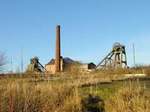
Technical > Winders

Section under repair
Introduction
There were a number of winders installed at Pleasley in the 19th and early 20th century. Originally, the North pit was the coal winding shaft and this had a more powerful engine and a larger drum than the South pit.
Both winders were originally squeezed back-to-back in the South end of the engine-house complex leaving a considerable empty space at the North end and, as a consequence, the North-pit overlap rope had to go out through the roof. This was a most unusual arrangement and the reason for it has been a puzzle for a long time.
A newspaper article written within a few days of the completion of the sinking in 1879 could shed some light on the mystery however. The article describes the problems encountered during the sinking resulting from heavy inflows of water and states that at the No. 1 shaft (which it refers to as the “Florence” shaft), four sets of pumps had to be installed, operated by a pair of 34 in. diameter steam engines. It also states that when the pumps were transferred to the No. 2 shaft (referred to as the “Nightingale” shaft), they were operated by a pair of 40 in. diameter high-pressure engines.
These dimensions are identical with those of the post-sinking winders and it may be that the front end of the North engine-house was occupied by the 34 in. engines rigged up for pumping. The more powerful 40 in. engines would have originally been ordered for coal winding duty and when pumping requirements had ended at No. 2 shaft they would have needed repositioning for winding at No. 1 shaft. Unfortunately, the 34 in. engines, originally ordered for winding duty at No. 2 shaft, could not be repositioned until the 40 in. ones had been moved and the only place available to relocate these was in the middle of the engine-houses. There would be little point in moving them again, so there they stayed.
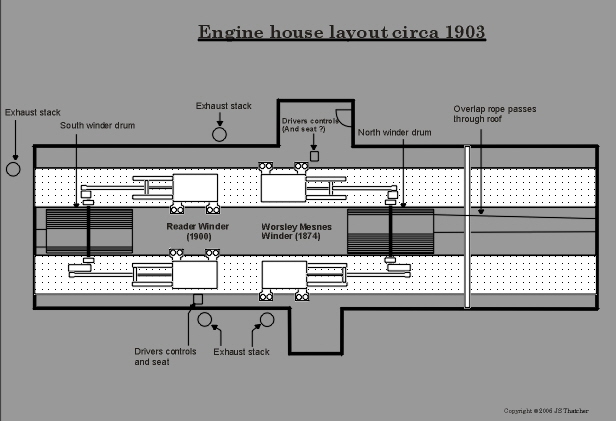
General layout of the engine-houses circa 1904
The winders in use at Pleasley in the 1890s were manufactured by the Worsley Mesnes company in Wigan and are reported to have had both steam-brakes and foot-brakes. The use of a footbrake has given rise to some surprise given the size of the drum on the North winder.
This seemingly improbable idea, however, was quite common in the 1800s and was still in use until the end of the 20th century. At Donisthorpe colliery (Leicestershire) a Worsley Mesnes engine was still in use in 1990. Here the driver stood with his foot on a dead-man foot-brake with the throttle and reversing levers in either hand, the foot-brake operating via the steam-brake.
A similar arrangement can be seen on the Worsley Mesnes winder at Bestwood Collierywhich was installed in 1876.
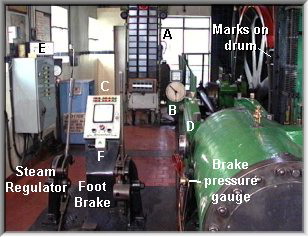
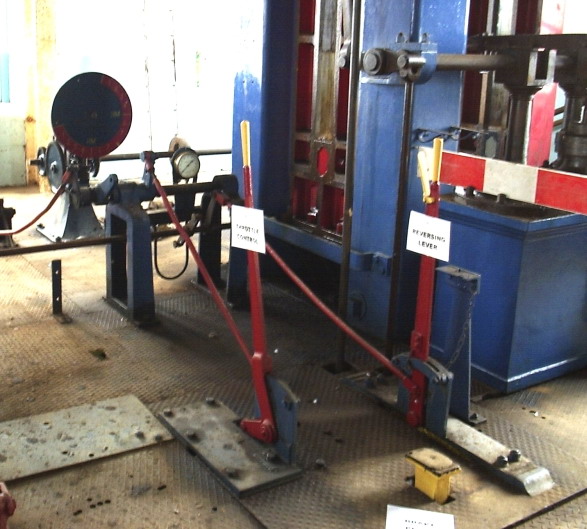
Drivers controls on the Worsley Mesnes winder at Bestwood Colliery
Worsley Mesnes winder at Donisthorpe Colliery circa 1990
Early foot-brakes fitted to winding engines employed a linkage arrangement which applied a large force to tighten a band around the brake-path despite only a small force being applied to the pedal. The steam brake was used to apply the brake once the winding drum was halted but could be applied in an emergency, although damage was likely to be caused due to the sudden shock to the winder and cage suspension components. They had the disadvantage of being inoperative if there was little or no steam pressure, but this was later overcome by adding a weighting device which the driver could apply by hand.
Subsequent changes to this system saw the steam-brake being used to supplement the action of the foot-brake, but the application of the steam tended to impose an abrupt force on the brake. An improvement came with the addition of a “cataract” (damping) cylinder to the brake engine which slowed the abrupt action somewhat. Another improvement came with a proportional-valve arrangement which controlled the pressure of steam applied to the brake according to the amount of movement of the drivers brake lever. A later development saw a brake-engine whose movement matched that of the drivers lever by means of a floating linkage connected to the the brake operating lever and to the drivers lever.
At the same time as these improvements were being made to the brake-engine itself, brake application mechanisms were changing from application by pressure (foot/steam) to application by dead-weight and release by pressure (steam/compressed air). In addition, the inclusion of a spring in the brake-engine linkage also improved the smoothness of application whilst automatic adjusters helped ensure consistent application.
To be added:
- problem of speed of application of service brakes in an emergency and Black’s idea of spring operation by toggle release.
- Also issues of brake shoe contact geometry.
In 1900 the South pit was upgraded to full coal winding and a larger winder was installed to handle this. A short time later the North winder suffered a catastrophic drum-shaft failure and a complete new winder was subsequently installed - this engine remaining in service until closure.
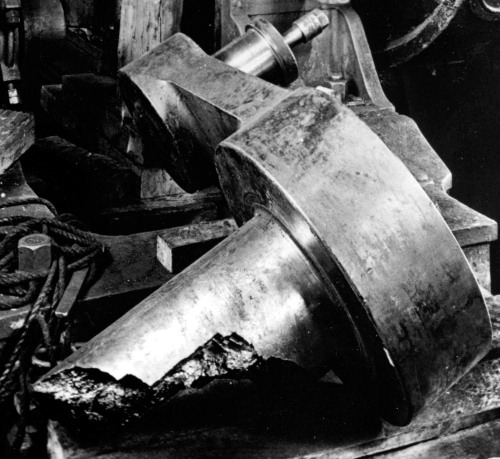
Fractured drum shaft end on North winder (FoPP/JST)
The damage occurred in the RH bearing journal and appears to be a fatigue fracture. The actual cause is unknown, but it is suspected that it may have been a result of operating the winder with steam from the new boilers at 100 psi rather than the 50 psi it was designed for.
In June 1904 it was decided to replace the North winder. Drawings were produced by the Lilleshall Co. in October and the new winder began operations in April 1905. The new winder was positioned fully in the North engine-house with both ropes now passing through the end-wall which was partially rebuilt to accommodate them. It would appear that the Worsley Mesnes winder was still in use when the replacement was being installed since it was only just squeezed in beyond the end of the old bedframe, with no clearance between the front of the new bedframe and the engine-house end wall. Some parts of the old engine were reused however, including the governor and the reversing engine.
Part missing from here
During 1919-20, the South shaft was deepened and the main winder was used for the sinking operation, but when this had been completed a temporary winder had to be installed whilst the old winder was removed and the new one installed. There was a disused double-drum haulage engine on the North pit-top and this was dismantled and re-erected between the fan-houses and the South headstock. Unfortunately, shortly after it began operation in January 1922, an overwind accident occurred which sent the cages to the bottom of the shaft and completely smashed the engines. It was eleven months before a replacement winder had been purchased from Gilfach Colliery in South Wales and had been erected in place of the damaged one. This winder was built by Thornwill and Warham and had 32 in. diameter cylinders with a 66 in. stroke. It was later transferred to Bilsthorpe colliery where it was used in 1925 to sink the upcast shaft, and continued in use there for winding men and occasionally coal until 1978.
Once the new engine-house had been completed, the 1900 winder was removed and the new, more powerful, Markham winder was installed, remaining in use until closure. The fate of the 1900 Reader winder is currently uncertain although at the beginning of the 1950s, one of the Silverhill winders was reported to be of this manufacturer.
Sources
- Mansfield and North Notts. Advertiser, 1877, 1879
- Colliery Guardian 1891
- Trans Fed Inst Min Eng 1891, 1902
- Stanton Ironworks Co. Technical Reports 1920 - 1925
- Journal Notts. Mining Students Assoc. 1923
- Colliery Engineering 1952
Copyright © 2023 J.S. Thatcher
Page updated on:
11 Nov, 2023
at
05:24:42 PM
In case of problems contact: